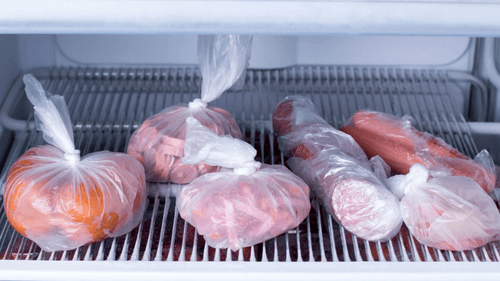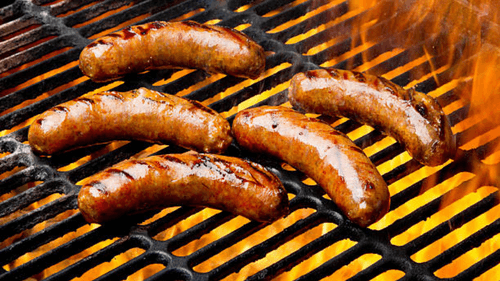Can you freeze sausages? Freezing guide
Not all sausages are made the same. There are fresh, cured, smoked, and pre-cooked sausages, which are all delicious. However, the problem with sausages is that the best deals are always in big packs, where you get far more sausages than you can eat in one sitting. How do you store sausages long-term?

Did you know sausages became known as badgers in WW2? The sausages would essentially explode when being cooked due to the high water content they contained! The longest sausage ever made was in Romania in 2014. The sausage was 62.75 kilometers long. That’s almost 40 miles!
The ubiquitous lip-smacking sausages are everywhere in the western world in many guises, from hot dogs to breakfast sausages and salami. This article dives into the world of sausages to uncover how you can store sausages for longer, preventing waste. We answer many frequently asked questions to provide you with factual information.
Let’s get into it.
Do sausages expire?

Yes. But not all sausages are the same, so they have different shelf lives.
The US government’s official definition of fresh sausages is “a coarse or finely ‘comminuted’ (reduced to minute particles) meat food product manufactured from one or more kinds of meat, or meat and meat “byproducts,” and they are marketed raw.
As a result, you should handle these fresh sausages similarly to how you would like any perishable food. Fresh sausages should be kept in the refrigerator, and if the links are left out and not chilled for more than two hours, you should probably throw them away.
Additionally, you should only purchase as much raw sausage as you can consume within a couple of days. No matter whether the packaging is opened or not, a pack of fresh sausages will only keep in your fridge for one to two days, according to USDA FSIS recommendations.
Cooking fresh sausages before putting them in the fridge will help to slightly increase their shelf life to three to four days. The FSIS experts advise placing cooked sausage “in shallow containers for fast chilling” and then refrigerating it within two hours if you want to store it safely.
Precooked Sausages
Sausages that have already been cooked.
It’s okay to desire something quick and simple, like precooked sausage, occasionally. Like hot dogs or certain pre-packaged breakfast sausages, these sausages are ready to consume after being heated. Reading the label on the container will allow you to determine whether your sausage has been pre-cooked. They have a substantially longer shelf life than raw sausage because they have already been cooked.
According to recommendations from the USDA FSIS, an unopened container can stay fresh in your fridge for up to two weeks, but you should utilize an opened package within a week.
Dried sausages
You don’t need to refrigerate dried sausage, like pepperoni, if you buy them whole because they will keep for up to six weeks in a cool pantry.
According to the USDA FSIS, they are “mostly, but not entirely, cooked.” However, if you do store these dry sausages in the refrigerator, they will remain fresh for up to three weeks after opening and for an infinite period before.
According to the FSIS specialists, some dry sausages are shelf stable, meaning they may be properly stored without refrigeration or freezing. However, always read the label before leaving a piece of sausage out at room temperature in the hopes that it would be fine to eat.
Do sausages need to be refrigerated?

Not all sausages need to be refrigerated.
Uncooked sausage can be stored in the refrigerator for one to two days.
Up to four days can pass after cooking sausage.
Other factors, such as the sausage’s preparation and storage environment, also affect how long the sausage lasts.
Prepackaged sausage that has not been opened and usually has a “sell by” or “use by” date can be put in the refrigerator as soon as it is received.
It’s preferable to err on the side of caution and toss the sausage if you are unclear about how long it has been sitting in the refrigerator.
This is what the USDA has to say about sausages. Excerpt from the USDA 79 words
KNOWLEDGE ARTICLE
All sausages- except dry sausage – are perishable and must be kept refrigerated or frozen. Uncooked fresh sausage can be stored in the refrigerator for one to two days; after cooking.
Keep it refrigerated for three to four days (40 °F or less). Hard or dry sausage (such as pepperoni and Genoa salami), whole and unopened, can be stored indefinitely in the refrigerator or for up to six weeks in the pantry. After opening, refrigerate for 3 weeks.
Do sausages have to be covered?
Yes, when storing sausages in the fridge, cover them. This applies to fresh, cooked, and pre-cooked sausages. Fresh sausages have a short shelf life. They are essentially raw meat, raw meat with herbs and spices, and bread crumbs with some flavorings, and that’s about it.
Traditional breakfast sauces are pork, so it is a great idea to cover the sausages to prevent bacteria build up on the sausages.
Can you put a warm sausage in the fridge?

It is not advisable, but sometimes you may not have a choice.
If you read online that you can’t put a warm sausage in the fridge because of condensation coalescing into water droplets that will drip and make your sausage soggy and less appealing at best is the main reason you can’t put the warm sausage in the fridge, you are being misled.
Your fridge temperature will be 40℉ -18℃ or a little lower. Placing a warm sausage in the fridge will elevate its temperature while it radiates heat.
Your fridge may not be as efficient as you might have thought at removing heat. Most fridges take hours to come to 40℉ after being switched on after cleaning.
So, what’s the big deal? The big deal is that food sitting at a temperature of 40-140℉ is in the food danger zone. It’s not just your sausage. It is the contents of the entire fridge.
Above 40℉-18℃ bacterial growth on perishable foods will accelerate exponentially. It should be discarded if the food remains at an elevated temperature above 40℉-18℃ for just two hours.
Seems harsh? According to the USDA, after two hours in the food danger zone, perishable foods contain enough bacteria to cause food poisoning.
Furthermore, the sausage should be covered in the fridge so there will be no condensation!
What happens if you have no choice, you need to be out of your home for a few hours? Separate the sausages, so they are not touching. This will allow the heat to dissipate and the sausage cools faster. Place the sausage in an airtight container.
If you are out of time, wrap the sausage container in a towel to act as insulation to prevent the fridge from heating dramatically.
How long can warm cooked sausage sit out?
Two hours. Remember the food danger zone? According to the USDA, perishable goods sitting out for two hours should be discarded, and the bacteria growth on the food has multiplied rapidly, making the food unfit for consumption.
Eating food sitting out for two hours or more could cause food poisoning.
How long does cooked sausage last in the fridge?
What is the shelf life of cooked sausages in the refrigerator? Refrigerate sausages within two hours of cooking for the best results; the specific response to that question heavily relies on storage conditions.
Fresh sausages have a shelf life of two days.
Vegetarian sausages generally have a shelf life of 6 days in the fridge.
Cooked sausages should be stored in shallow airtight containers in the refrigerator or should be tightly wrapped in heavy-duty aluminum foil or plastic wrap to extend their shelf life and maintain their freshness.
Cooked sausages have a shelf life of 3 to 4 days when kept properly.
Do frozen sausages go bad?
In theory, frozen foods last indefinitely when at 0℉ and below, but sausages seem more delicate than you may think; they have a high-fat content that does not freeze well and can go rancid.
Freezing fresh sausages:
- Be aware that you are handling raw meat so take the necessary precaution not to cross-contaminate work surfaces and utensils. Wearing disposable gloves is a good idea.
- Cut the sausage links so you have individual sausages, and place them on a baking tray.
- Place the baking tray in the freezer and let the sausages freezer for two hours, this will prevent the sausages from freezing in a clump, and you can retrieve the number of sausages you want.
- Retrieve the frozen sausages and place them into a freezer bag, Ziploc, or similar work well.
- Remove as much air from the bag as possible and seal it tightly.
- Mark the bag with “uncooked sausages” and the freezing date plus the expiry date.
- Place in the freezer.
Freezing cooked sausages
- Ensure the sausages are at room temperature while being mindful that sausages can only sit out for two hours.
- Wrap the cold sausages in cling wrap. If you wrap them individually, they can be packed in a larger freezer bag.
- Once the cooked sausages are wrapped, place them in a freezer bag such as Ziploc. You can pack them in portion sizes if you wish.
- Remove as much air from the bag as possible and seal it tightly.
- Mark the bag with “uncooked sausages” and the freezing date plus the expiry date.
- Place in the freezer.
Frozen sausages, cooked or uncooked, have a similar shelf life of approximately 3 months, but they are considered better if consumed within 8 weeks of freezing.
Final Thought
Freezing leftovers or just buying in bulk for a better deal is tempting, and now you know that you can keep cooked and uncooked sausages in the freezer ready for the lips making sizzle when you need them.
This short table will help jog your memory for refrigeration and freezing.
| Product | Refrigerator 40 ℉ | Freezer 0 ℉ |
| Sausage, raw – from pork, beef, turkey | 1-2 days | 1-2 months |
| Smoked breakfast links, patties | 7 days | 1-2 months |
| Hard sausage | Opened: 3 weeks. Unopened: indefinitely | 1-2 months |
| Summer sausage labeled “keep refrigerated” | Opened: 3 weeks. Unopened: 3 months | 1-2 months |





